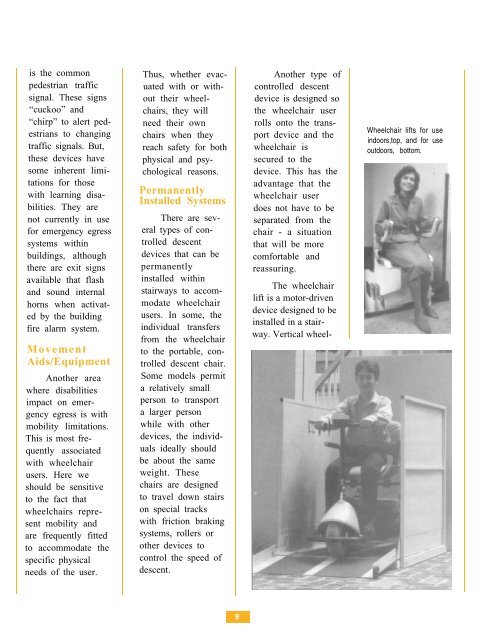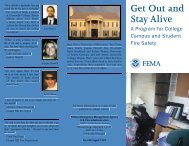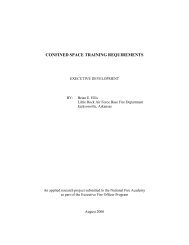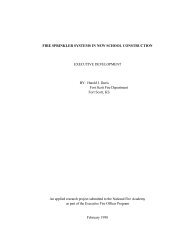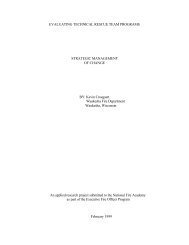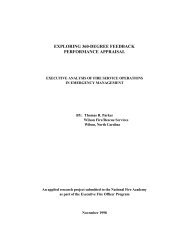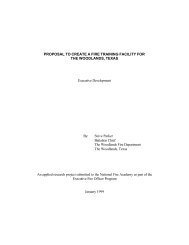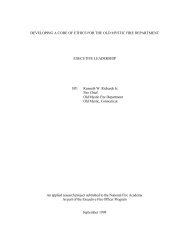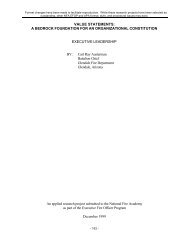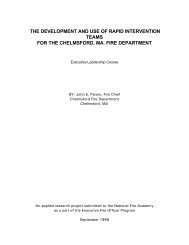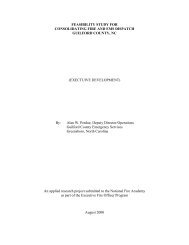Emergency Procedures for Employees with Disabilities - US Fire ...
Emergency Procedures for Employees with Disabilities - US Fire ...
Emergency Procedures for Employees with Disabilities - US Fire ...
You also want an ePaper? Increase the reach of your titles
YUMPU automatically turns print PDFs into web optimized ePapers that Google loves.
is the common<br />
pedestrian traffic<br />
signal. These signs<br />
“cuckoo” and<br />
“chirp” to alert pedestrians<br />
to changing<br />
traffic signals. But,<br />
these devices have<br />
some inherent limitations<br />
<strong>for</strong> those<br />
<strong>with</strong> learning disabilities.<br />
They are<br />
not currently in use<br />
<strong>for</strong> emergency egress<br />
systems <strong>with</strong>in<br />
buildings, although<br />
there are exit signs<br />
available that flash<br />
and sound internal<br />
horns when activated<br />
by the building<br />
fire alarm system.<br />
Movement<br />
Aids/Equipment<br />
Another area<br />
where disabilities<br />
impact on emergency<br />
egress is <strong>with</strong><br />
mobility limitations.<br />
This is most frequently<br />
associated<br />
<strong>with</strong> wheelchair<br />
users. Here we<br />
should be sensitive<br />
to the fact that<br />
wheelchairs represent<br />
mobility and<br />
are frequently fitted<br />
to accommodate the<br />
specific physical<br />
needs of the user.<br />
Thus, whether evacuated<br />
<strong>with</strong> or <strong>with</strong>out<br />
their wheelchairs,<br />
they will<br />
need their own<br />
chairs when they<br />
reach safety <strong>for</strong> both<br />
physical and psychological<br />
reasons.<br />
Permanently<br />
Installed Systems<br />
There are several<br />
types of controlled<br />
descent<br />
devices that can be<br />
permanently<br />
installed <strong>with</strong>in<br />
stairways to accommodate<br />
wheelchair<br />
users. In some, the<br />
individual transfers<br />
from the wheelchair<br />
to the portable, controlled<br />
descent chair.<br />
Some models permit<br />
a relatively small<br />
person to transport<br />
a larger person<br />
while <strong>with</strong> other<br />
devices, the individuals<br />
ideally should<br />
be about the same<br />
weight. These<br />
chairs are designed<br />
to travel down stairs<br />
on special tracks<br />
<strong>with</strong> friction braking<br />
systems, rollers or<br />
other devices to<br />
control the speed of<br />
descent.<br />
9<br />
Another type of<br />
controlled descent<br />
device is designed so<br />
the wheelchair user<br />
rolls onto the transport<br />
device and the<br />
wheelchair is<br />
secured to the<br />
device. This has the<br />
advantage that the<br />
wheelchair user<br />
does not have to be<br />
separated from the<br />
chair - a situation<br />
that will be more<br />
com<strong>for</strong>table and<br />
reassuring.<br />
The wheelchair<br />
lift is a motor-driven<br />
device designed to be<br />
installed in a stairway.<br />
Vertical wheel-<br />
Wheelchair lifts <strong>for</strong> use<br />
indoors,top, and <strong>for</strong> use<br />
outdoors, bottom.


